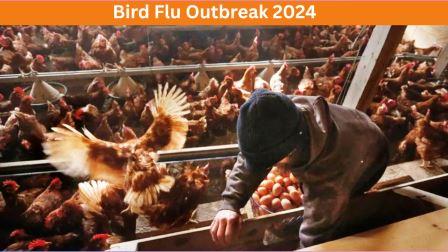The Michigan Department of Health recently announced the nation’s second human case of H5N1 bird flu linked to an outbreak in dairy cows. This case, involving a farm worker who was exposed to infected cows, underscores the ongoing concerns and monitoring efforts related to the H5N1 virus. Here’s what you need to know about this development and its implications.
The Case in Michigan
A Michigan farm worker has been identified as the second person in the United States to contract the H5N1 bird flu virus linked to dairy cows. This announcement follows a similar case in Texas, marking a rare instance of human infection with this virus. According to state health officials, the individual experienced mild symptoms and has since recovered. Testing revealed a positive result for H5 flu virus from a swab taken from the individual’s eye, with final confirmation pending genetic sequencing.
The H5N1 Outbreak: A Closer Look
The current outbreak, unusual due to its presence in dairy cows, was first confirmed in late March but likely began several months earlier. Since then, the USDA has reported outbreaks in 52 herds across nine states, with Michigan being particularly affected, reporting 19 infected herds.
Experts believe the actual number of affected herds may be significantly higher due to reluctance from farmers to allow testing, fearing stigma. However, Michigan has been proactive in its response, with state health authorities implementing aggressive monitoring and testing strategies.
Public Health Response and Monitoring
Michigan’s health officials have been diligent in tracking and testing farm workers exposed to the virus. Over 35 people have been tested so far, with the recent case being the first to return positive. The state has also implemented measures to enhance biosecurity on farms and has been encouraging cooperation from farmers to report any infections.
Bird Flu Outbreak 2024: Understanding the Risks and Taking Precautions
The recent emergence of a highly pathogenic avian influenza (HPAI) strain, commonly referred to as “bird flu,” has caused concern across the globe. Since late 2021, a particularly contagious strain, H5N1, has been responsible for devastating outbreaks in poultry farms worldwide. As of May 2024, the outbreak continues, with ongoing cases reported in various countries.
Understanding the Bird Flu Outbreak: A Global Challenge
The current bird flu outbreak is the largest and most widespread ever recorded. The H5N1 strain responsible has caused mass die-offs and culling of poultry flocks in Europe, Asia, Africa, and North America. The virus spreads rapidly among birds, primarily through their droppings and respiratory secretions. Wild migratory birds play a significant role in disseminating the virus across vast distances.
The economic impact of the bird flu outbreak has been substantial. Millions of birds have been culled to control the spread, causing significant losses for poultry farmers. Additionally, disruptions in the global poultry supply chain have led to rising egg and meat prices for consumers.
Can Humans Get Sick from Bird Flu? The Risk and Transmission
While the primary concern lies with poultry, humans can get sick from bird flu. However, the risk for healthy individuals remains relatively low. Human infections with H5N1 are uncommon, and most reported cases have involved people working directly with infected birds. The virus typically transmits through close contact with infected birds or contaminated surfaces.
The recent detection of H5N1 in dairy cattle in the United States raises new concerns. While the origin of this transmission is still under investigation, it highlights the potential for the virus to mutate and adapt to new hosts. The two human cases of H5N1 infection linked to these dairy cattle outbreaks serve as a reminder that ongoing vigilance is crucial.
Will Bird Flu Become a Pandemic? Preparing for the Future
The primary concern surrounding the bird flu outbreak is its potential to evolve into a human pandemic. Experts believe the risk is currently low. However, the ongoing circulation of the virus among birds and the recent spillover events to mammals warrant close monitoring and preparedness efforts.
The ability of the H5N1 strain to mutate and potentially gain the ability to efficiently transmit between humans is a critical factor in determining pandemic risk. Public health agencies worldwide are actively monitoring the virus and conducting research to understand its evolution and develop potential vaccines.
Taking Precautions: Protecting Yourself and Your Community
While the immediate risk for most people remains low, taking precautions is essential. Here are some key steps to prevent the spread of bird flu:
- Avoid contact with sick or dead birds: Do not touch or handle wild birds found dead. If you find dead birds, report them to your local wildlife agency.
- Practice good hygiene: Wash your hands thoroughly with soap and water after handling poultry or eggs.
- Cook poultry thoroughly: Ensure poultry reaches an internal temperature of 165°F (74°C) to kill any potential viruses.
- Stay informed: Follow updates from public health agencies about the bird flu outbreak and any recommended precautions.
By following these simple precautions, you can help minimize the risk of transmission and contribute to controlling the bird flu outbreak.
Conclusion: A Global Challenge Requires a Global Response
The ongoing bird flu outbreak presents a significant challenge for the global community. While the immediate risk to human health may be low, continuous monitoring and preparedness efforts are critical. By collaborating across borders, sharing information, and developing effective prevention and control strategies, we can minimize the impact of this global outbreak and mitigate the potential for a pandemic. Remember, remaining informed and taking necessary precautions can significantly contribute to protecting yourself and your community from the bird flu.
